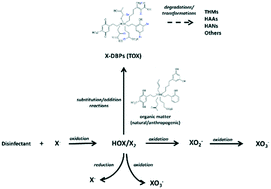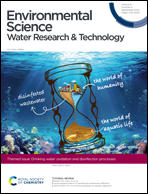The forest or the trees: a critical review on the analysis of total organic halogen (TOX) in drinking waters and its utility as a water quality parameter†
Abstract
The formation of disinfection by-products (DBPs) is challenging from both public health and drinking water treatment perspectives. Over 700 DBPs have been identified, however, a large proportion of halogenated DBPs are unknown, and the compounds responsible for the observed associations between consumption of disinfected drinking water and adverse health outcomes have yet to be identified. The measurement of total organic halogen (TOX) provides the only measure of the overall formation of halogenated DBPs, and is an attractive alternative to the measurement of individual DBPs. This paper presents a critical review of the analysis of TOX and the utility of TOX as a water quality parameter in drinking water treatment. In TOX analysis, the evolution of instrument technology has improved the sensitivity and selectivity of the measurement, and the use of good quality activated carbon was found to be crucial to achieving good recoveries (>90%). The concentrations of TOX in drinking water are not static, with the transformation or degradation of TOX over time forming smaller DBPs. Advanced oxidation processes (AOPs) could reduce or promote the formation of TOX as a result of transformations of precursor materials. Evaluation of the available existing data showed strong correlations between molar concentrations of TOX, and THMs and HAAs. Positive correlations between the concentrations of TOX and the in vitro toxicity of disinfected waters have also been reported. Therefore, one measurement of TOX can potentially provide information on the levels of regulated DBPs and toxicity in a sample, which means that a comprehensive assessment of water quality can potentially be achieved with a single measurement of TOX.

- This article is part of the themed collection: Drinking water oxidation and disinfection processes


 Please wait while we load your content...
Please wait while we load your content...